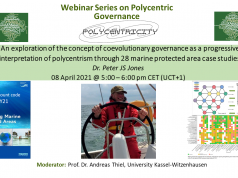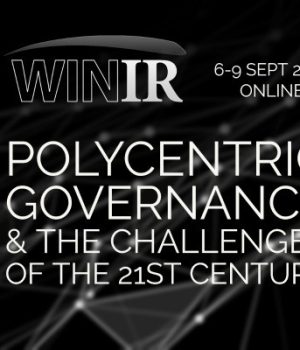Dear colleagues and friends,
Please find attached a CfP on “Beyond the government-market-communities trichotomy: conditions and instruments for cooperative, coercive and competitive interactions in natural resource and agri-environmental governance”. (ABSTRACT also by the end of the email text)
We hope it is of your interest or the interest of colleagues of yours. Feel free to distribute widely.
The deadline for submission of abstracts is 2 January 2019.
A selection of potential contributors will be invited to present their work at a one and half day workshop in March 2019 (funded by Käte Hamburger Kolleg for Global Cooperation Research, University of Duisburg-Essen).
We hope you find this call of interest.
Sergio, Andreas, Liz and Mark
— — —
Abstract
In the last decades, the scope of governance actions for natural resource and agri-environmental governance has increased substantially. The old trichotomy of governance by government, governance by markets and governance by communities has been replaced by a new interest in hybrid arrangements (e.g., co-management, payment for ecosystem services, participatory decision making, public-private partnerships, ad hoc conflict resolution fora, contracting out) in the recognition that no single agent possesses the capabilities to address the multiple facets, interdependencies, and scales of environmental problems. In this Special Issue (SI) we take stock of the nascent literature on hybrid governance arrangements and set an agenda for further progress. We take particular interest in the coercive, cooperative and competitive interactions among and between governments, firms, and local communities as they develop over time and at different levels of governance. The papers included in this SI encompass a diversity of environmental management contexts, but all share an underlying interest in the workings and socio-environmental outcomes of “hybrid arrangements”, and the conditions under which they promote coercive and/or cooperative and/or competitive interactions that contribute to sustainable resource management.
Full CfP
Call for Abstracts
Beyond the government-market-communities trichotomy: conditions and instruments for cooperative, coercive and competitive interactions in natural resource and agri-environmental governance
Proposing editors:
Sergio Villamayor-Tomas (Corresponding editor: villamayortomas@gmail.com)
ICTA, Autonomous University of Barcelona
Andreas Thiel, International Agricultural Policy and Environmental Governance, University of Kassel; Käte Hamburger Kolleg, Centre for Global Cooperation Research, University of Duisburg-Essen
Elizabeth Baldwin, School of Government and Public Policy
College of Social and Behavioral Sciences, University of Arizona
Mark Stephan, School of Politics, Philosophy, and Public Affairs
Washington State University
Abstract
In the last decades, the scope of governance actions for natural resource management and agri-environmental governance has increased substantially. The old trichotomy of governance by government, governance by markets and governance by communities has been replaced by a new interest in hybrid arrangements (e.g., co-management, community-based payment for ecosystem services, agro-environmental schemes, participatory decision making, public-private partnerships, pooled transferable quotas, cap-and-trade-systems, community conservation programs) in the recognition that no single agent or governance mode (governance by government, markets or communities) possesses the capabilities to address the multiple facets, interdependencies, and scales of environmental problems. In this Special Issue (SI) we take stock of the nascent literature on hybrid governance arrangements and set an agenda for further progress. We take particular interest in the coercive, cooperative and competitive interactions among and between governments, firms, and local communities as they develop over time and at different levels of governance. The papers included in this SI encompass a diversity of environmental management contexts, but all share an underlying interest in the workings and socio-environmental outcomes of “hybrid arrangements”, and the conditions under which they promote coercive and/or cooperative and/or competitive interactions that contribute to sustainable resource management.
- Motivation
In the last decades, the scope of governance alternatives for natural resource management and agri-environmental governance has increased substantially. Traditionally, private property and state management were considered as the two only governance options likely to foster the sustainable management of natural resources (Hardin 1968). Over the 80s and 90s, growing evidence showed that communities of natural resource users could also self-organize for the management of resources (Ostrom 1990, Poteete et al. 2010). Numerous decentralized policies, co-management arrangements, participatory decision making experiences and community-based conservation mechanisms followed up and acquired notable visibility with the turn to the new century (Berkes 2004, Ansell and Gash 2008).
Local collective action, however, should not be seen as an environmental governance panacea, nor as an alternative to market institutions or the government. Despite the current momentum of local collective management experiences, public administrations including national, regional, local and sometimes supranational governments still enjoy a great deal of influence over the management of natural resources. For example, governments often back up property regimes with formal monitoring and sanctioning mechanisms based on the state’s administrative capacities and coercive powers (Ostrom and Cox 2010). More importantly, governments and policy instruments, traditionally studied as alternatives to community-based natural resource management (see for example market instruments), may also play an important role in the promotion of collective action experiences (Mansbridge 2014) A good example in point is the practice and study of Payment for Ecosystem Services (PES). Although originally conceived as a pure market instrument where buyers and sellers transact ecosystem services (Engel et al. 2008), PES have more recently been highlighted for their dependence on government and community-based organizations (and NGOs), as well as their potential to strengthen local cooperation (Muradian 2013, Sikor et al. 2017).
While a number of policy studies (i.e., policy instrument choice theory) have theorized about the different instruments governments can use to solve environmental problems (Howlett 2004, Jordan et al. 2005, Goulder and Parry 2008), there is still rudimentary understanding about how those instruments shall productively combine at different levels of governance as designed and implemented by both governmental and non-governmental actors. The objective of this special issue is to start filling that gap while recognizing that, although certainly versatile (policies connect organizations and are constitutive of governance modes), an exclusive focus on policies may be limited. Thus, we do not see hybrids only as the result of combinations of (usually government-steered) policy instruments, but also as the result of more ‘organic’ ways of institutional emergence at more micro and macro scales.
- Previous works on hybrid modes of governance
The need to overcome the distinction and explore the coexistence between “the state”, “the market” and “the communities” in the governance of public and environmental affairs has been pointed out by previous studies. According to Lemos and Agrawal (2006) the trichotomy between governance by government, governance through markets and governance via self-organization is just analytical and needs to recognize the existence of numerous hybrid “forms of governance” such as “private-social partnerships” (e.g., government-led payment for ecosystem services and cap-and-trade systems), “co-management” (e.g., joint forest management, participatory decision-making) and “public-private partnerships” (e.g., concessionary arrangements). At a more micro-level, Menard (2004) has also theorized about the myriad of contracting options (i.e., governance arrangements) in-between spot markets and hierarchies (i.e., organizations) that provide for economic governance. These options include from sub-contracting and franchising to collective trade-marks, partnerships and cooperatives. At a more systemic level, Driessen et al. (2012) theorize about the existence of different “modes of governance” depending on the dominance exerted by the government over civil society (self-organized groups) and markets and vice-versa. They also associate different actor, institutional and policy features (including instruments) to each mode. Our special issue aims to build on these previous efforts and connect them by adopting a middle ground that, although interested in policy instruments, does not ignore the influence of governance arrangements (e.g., property rights, organizational features, contracts…) operating at a more macro and micro levels.
- Cooperation, competition and coercion interactions
This SI seeks to further our understanding of hybrid governance arrangements through the lens of multi-level governance. Multi-level governance is understood through the lenses of polycentricity as the action space where governmental and user-group organizations and firms interact with each other for the provision, production and consumption of public goods at different scales (McGinnis 1999, Hooghe and Marks 2003). Specifically, this SI focuses on the way ‘decision centres’ (i.e., governments and other organizations with certain capacity and authority for policy action) coordinate with each other via coercion, cooperation and/or competition and the extent to which these three types of interactions coexist across scales, governance functions and issues leading to desirable or undesirable outcomes. This fits Lemos and Agrawal’s (2006) interest in hybrid forms of governance and expands it by recognizing their embeddedness in and dependence on institutions operating at different levels. Similarly, the approach fits Menard’s view of contracting partners but does not limit it to the private sector and economic governance (this special issue is interested in public environmental goods). Finally, the SI recognizes Driessen’s et al. (2012) “modes of governance” distinction (i.e., the different ways that the government, firms and user group organizations divide labor and authority) but does not presume an alignment between the dominance of one actor or another (e.g., governments over communities or markets or vice-versa) and certain arrangements (e.g., policy tools). Ultimately the goal is to generate new theory on the coevolution of hybrid policy instruments and other institutional arrangements, and the conditions under which said instruments and arrangements contribute sustainable natural resource management by facilitating a productive coexistence of coercive, cooperative and competitive interactions.
- How the contributions relate with each other
The SI aims to cover a variety of cases including agricultural production and environmental management problems such as certification and control of agricultural value chains, climate change mitigation and adaptation, biodiversity conservation and city sustainability, and resource management contexts such as water, fisheries, air, energy and forest systems. They all share, however, an underlying interest in: (1) featuring the workings of hybrid forms of governance (e.g., co-management, payment for ecosystem services, agro-environmental schemes, pooled transferable quotas, participatory decision making, public-private partnerships, ad hoc conflict resolution fora, cap-and-trade systems, community-based conservation programs) as they promote the coercive and/or cooperative and/or competitive interactions among governments, firms, resource user and producer groups and civil society; and (2) identifying conditions under which coercion, cooperation and competition can reinforce each other to solve environmental problems.
Specific research questions that contributors address include:
- Which hybrid governance arrangements (including policy instruments but not only) feature environmental management policy across resource sectors? How those arrangements provide for cooperative, competitive and coercive inter-organizational interactions across decision making authorities?
- Are there patterns in the way governments, private firms and local communities engage in the design and/or use of policies that promote hybrid arrangements?
- Which rules, decision making logics, path dependencies, and/or power dynamics explain the patterns observed?
- Which institutional and actor configurations and policy processes contribute to the implementation of hybrid arrangements and their performance?
- How do hybrid arrangements change over time as influenced by governmental action?
To guarantee the coherence of the issue, a selection of potential contributors will be invited to attend a one and half day workshop (funded by Käte Hamburger Kolleg for Global Cooperation Research, University of Duisburg-Essen) where they will be asked to present their work and also provide feedback to other contributors. Possibilities to partially or fully fund participation in this event are available (funding of accommodation and workshop participation is mostly likely; funding of transportation costs is more limited).
The team has made initial contacts with high two high-impact, international journals in the social-environmental science and policy fields. The contributions selected to participate in the workshop will be included in the final SI proposal, which will be submitted to the chosen journal for final approval.
The workshop will take place on the 12th and 13th of March 2019, at the Käte Hamburger Kolleg for Global Cooperation Research, University of Duisburg-Essen in Germany (15 minutes from Düsseldorf airport, 2 hrs from Frankfurt and Amsterdam airports).
- Expected timeline
Abstract submission: 2nd of January (max. 350 words)
Internal selection of abstracts: before the 10th of January
Due date for extended abstracts for March Workshop (~2,500 words) submitted: 1 March
Workshop: 12-13 March
Full paper submission: mid-August 2019
Expected publication: Spring 2020












